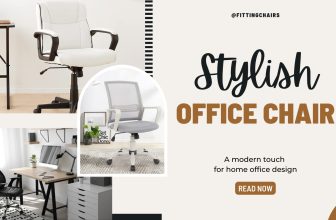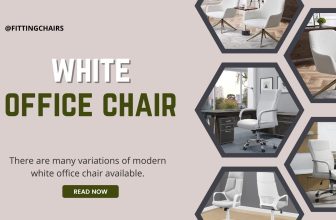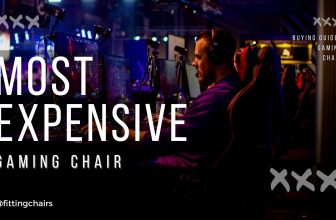Herman Miller is the brand behind some of the most well-known high-end ergonomic chairs on the market. What is the difference between the many seats offered by Herman Miller like Aeron vs Embody?
FittingChairs will go through what distinguishes these chairs from one another, from their design to their function.
Herman Miller Aeron vs Embody. The Story Behind
Herman Miller is a brand that prioritizes ergonomics over aesthetics, and the Aeron chair is an excellent example of this.
This seat has an arched backrest and a waterfall edge seat with an ultra-modern vibe that will make your working hours simpler.

The Embody office chair was designed by Herman Miller in collaboration with over 20 physicians. Its one-of-a-kind design aims to improve your workspace comfort.
Even though the chair is only available in one size, the multilayer seat accommodates various body types and ensures inclusion. Furthermore, it is entirely adjustable, allowing each user to adjust the height and armrests to their specific needs.
Herman Miller Aeron vs Embody. What’s The Same?
Let’s start with the similarities before moving on to the comparison.
The Herman Miller Aeron and Embody both have a 12-year warranty, which is the best in the industry.
Furthermore, you have 30 days to return either chair model for a full refund, with Herman Miller paying for return postage.
Both the Aeron and the Embody are highly effective ergonomic desk chairs that will improve user comfort, minimize pressure points and pain, align the spine, and allow the sitter to work for longer periods of time without being distracted.
Both of them build their fame on every top list of the best ergonomic chairs.
Support, comfort, design, and function are all perfectly balanced in the Herman Miller Aeron chair.
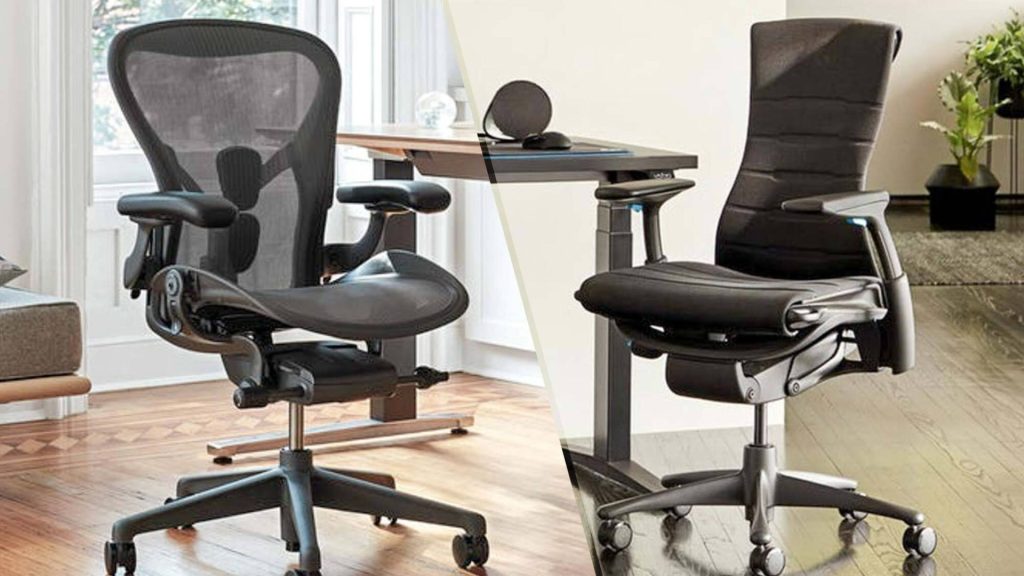
It’s become the ergonomic benchmark and one of the most widely recognized work chairs in the world today.
It’s part of the permanent collection at the Museum of Modern Art. Many people agree that it is a true piece of art.
The Herman Miller Embody is a well-known work chair that promotes good health.
Its one-of-a-kind structure, inspired by the human back, provides unrivaled support and adaptability, making it ideal for long periods of sitting and intense concentration.
Its stretchy canvas, which is combined with a skeleton structure, is extremely revolutionary.
Herman Miller Aeron vs Embody. What’s The Difference?
Size
With the Aeron and Embody, Herman Miller took two different approaches to size. They chose three distinct size options for the Aeron.

These are the sizes: A, B, and C. They come in three sizes: small, medium, and giant. Because we selected to test the size B, the specifications listed below are for the size B.
The Embody comes in only one size and is designed to fit a wider range of people than any of the Aeron’s single alternatives.
Design
The seat and back architecture is one of the most significant variations between the Embody and the Aeron. The Aeron features a mesh back and seat, whereas the Embody is more upholstered.
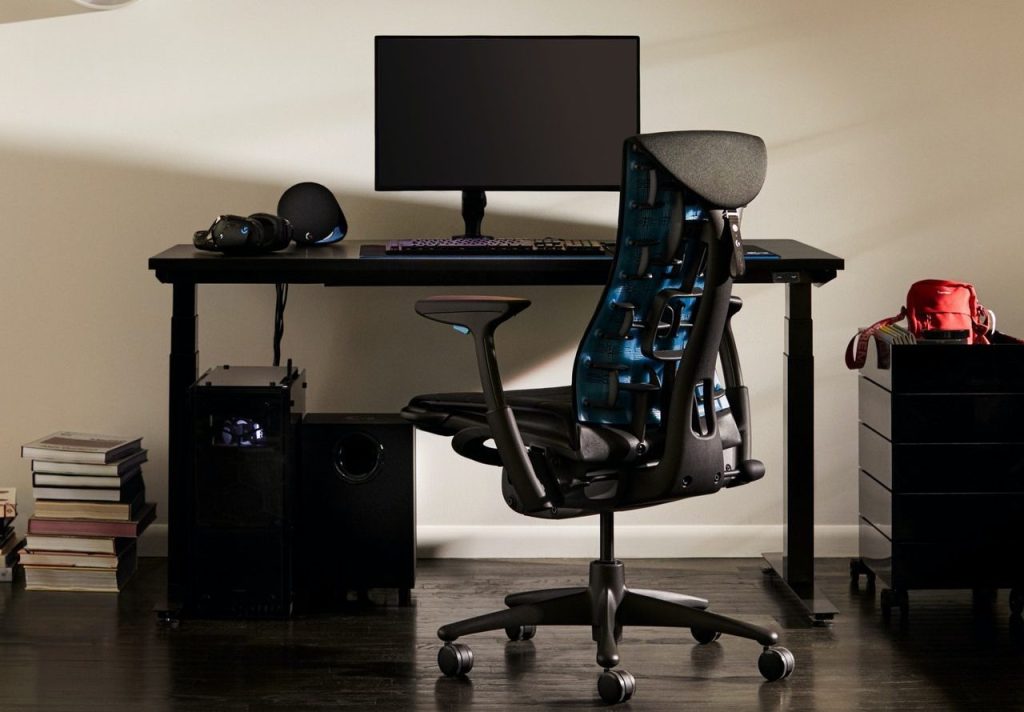
The backrest on the Embody is also taller than the Aeron’s, reaching all the way to your shoulder blades.
It’s also a little more curved than the Aeron, with “pixelated support” — a series of contact points designed to hug your spine and provide support when you shift in your seat — along the back.
This design, according to the firm, helps to properly disperse weight as you walk around.
The Aeron is now being made with 2.5 pounds of plastic recovered from oceans, while the Embody is made of 42% recycled materials.
When purchasing the Embody, you have the option of selecting the frame color, upholstery, and caster type.
Color Options
The Aeron is only available in grays and blacks, perhaps because it was created for an office environment.
The Embody has a smaller color palette, but it comes with white accents and a variety of upholstery colors, including red, green, and blue.
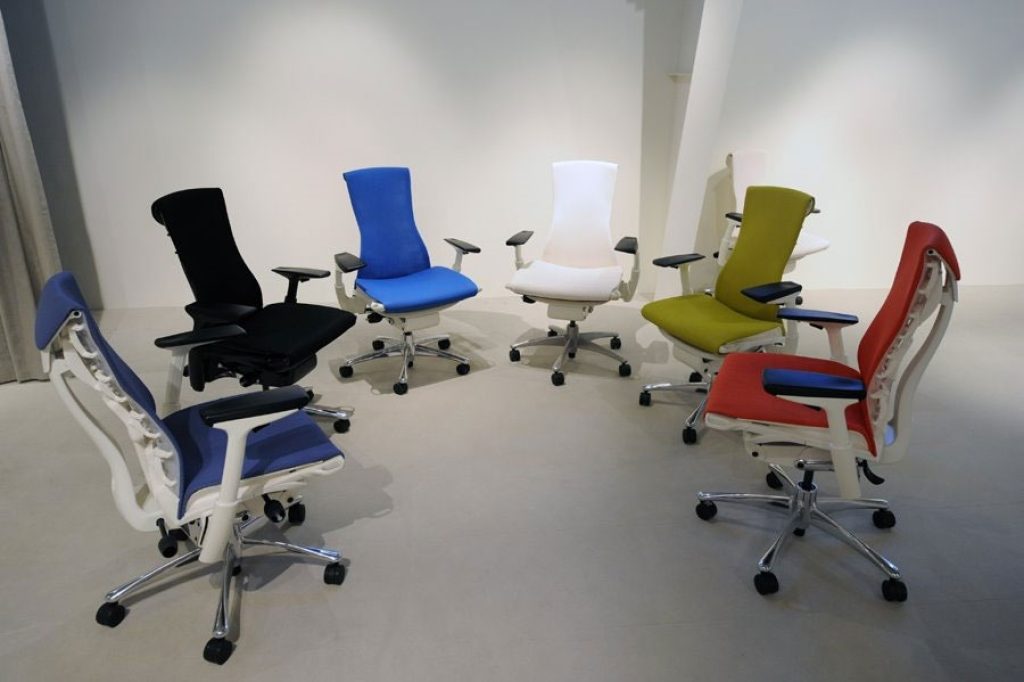
Personalization
The Aeron has a lot more options.
The Aeron chair is available in three sizes to accommodate persons of all shapes and sizes.
You can also select your preferred back support with features of basic, adjustable lumbar, or adjustable PostureFit SL, the tilt mechanism, totally adjustable or party adjustable, or fixed arms in a standard or leather armpads options.
Adjustability and Comfort
The Aeron chair comes with a variety of mechanisms. The typical tilt feature with tension control is included in the basic mechanism.
You can also upgrade to a mechanism with three locked positions and the ability to tilt the seat forward.
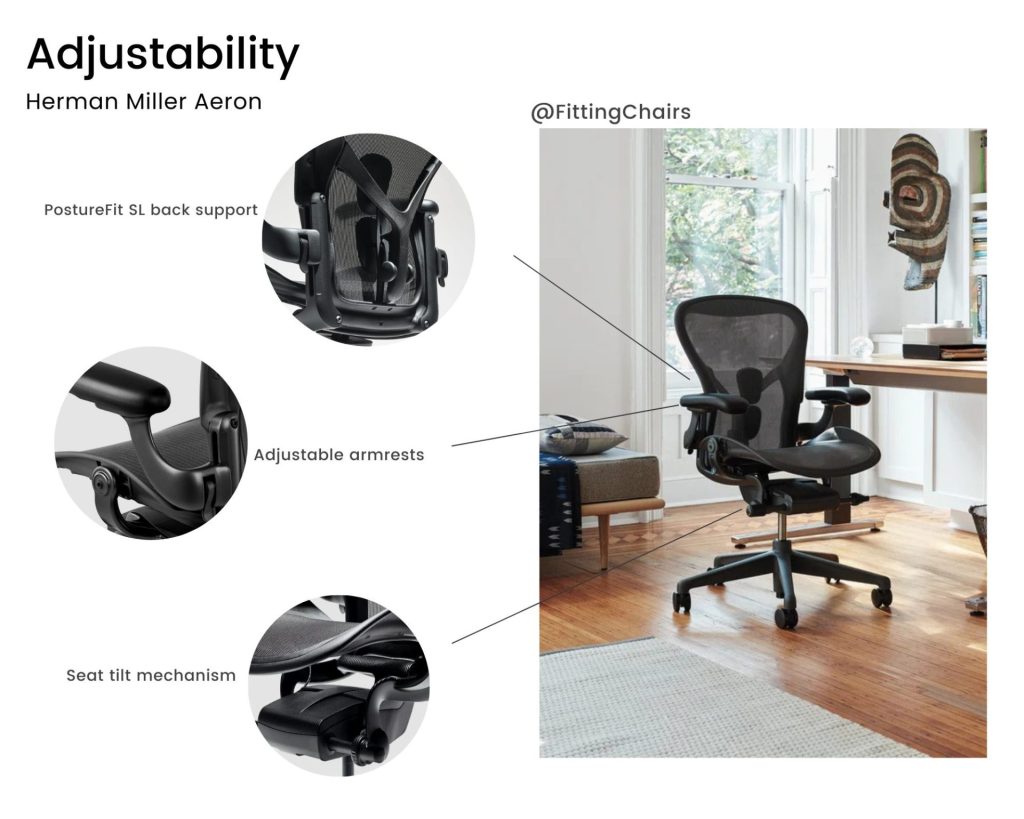
Because of the Aeron’s knee-tilt mechanism, it feels more natural to rock back and forth with it than with the Embody.
The Embody makes up for its lack of size options with adaptability. It offers a wide seat height range, as well as arm width and seat depth adjustments.
Because of these features, the Embody is a good choice for a wide spectrum of consumers.
The Embody also makes it easier to move around because the seat and back are both flexible, allowing you to move freely. With its more robust frame, this is not possible in the Aeron.
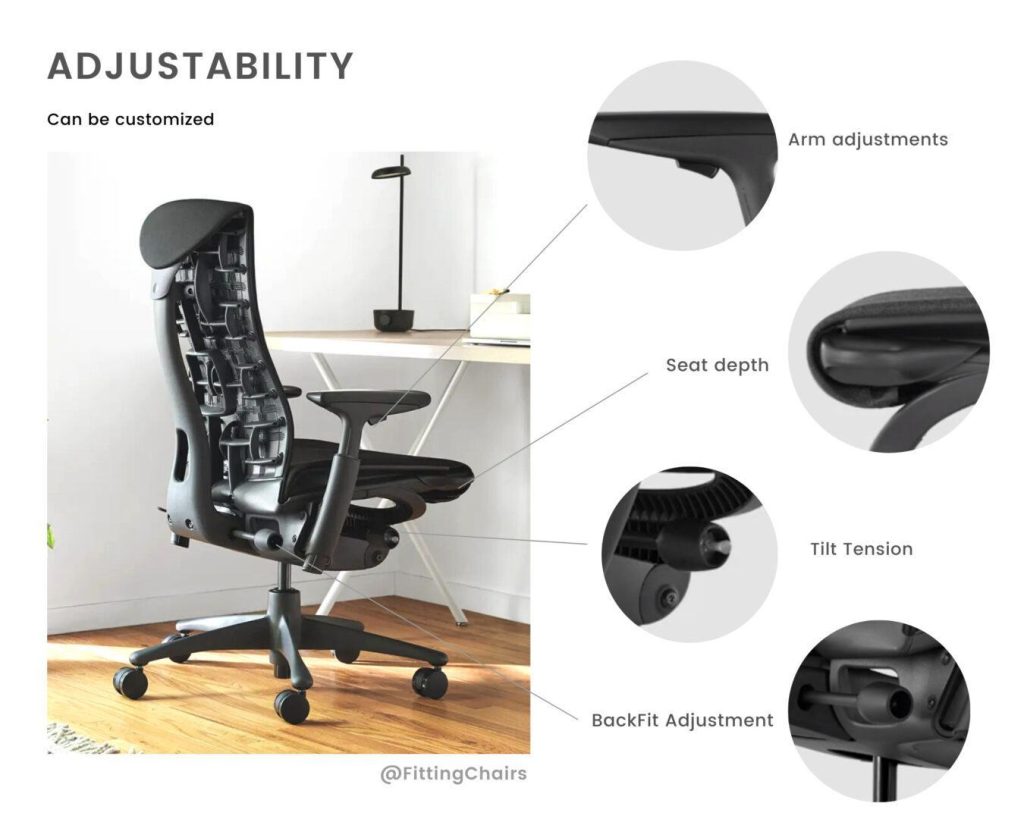
In terms of comfort, the Herman Miller Aeron once again outperforms the Embody.
The Aeron, in our opinion, has an advantage because of its cool breathability, which is especially important if you need to work in hotter areas.
The adjustable lumbar support is also a great feature for supporting your lower back.
In other words, in comparison of the Steelcase Gesture vs Herman Miller Embody, you can find more easily when adjusting your chair with the Embody.
What’s Customer Say?
Herman Miller Aeron Review
Positive Review
Kevin reviewed 5 stars “Awesome Chair! No con’s at all.”
“The Aeron Chair is worth every penny. Like most people in office environments, work study, play WOW have issues with finding the right chair.
Having a chair that is actually sized more for your height and weight makes a huge difference by itself as opposed to one size fits all, I’m 5’11 /155 lbs, ordered the Size B, building a chair on the Herman Miller site to assure proper fit for me.
Convinced its directly related to health at the end of the day, so I won’t say I wish it was cheaper because it probably wouldn’t be the quality that it is and I would be wanting to swap it out right away. Plus it looks a lot better in person, noticed I don’t lean forward, or twist and turn as much as I normally do.
The chair came in a box fully assembled as others mentioned, I did swap out the casters, not that the original ones were bad; honestly didn’t use them but to move 5 feet and back, the carpet with roller blade type casters seem to move across 1/4″ carpet a little easier.
I have never been 100% happy with any chair without finding flaws just after a few hours, being in IT and previous sales, have sat in my fair share of chairs as most of us have. I’m certain I will continue to buy this chair from now on for home use.”
Show more +Justin said “The only thing that fixed my lower back pain”
“Switching to working from home has caused me to not only be sitting more often, but to be sitting in my subpar desk chair. This has caused me to get lower back pain since it has no lumbar support and is not very ergonomic.
In my search for a solution to the problem I have tried 3 other chairs: Steelcase Leap v2, Herman Miller Embody, Autonomous Ergochair 2.
All of these chairs were OK but had major flaws in comfort for me, especially considering the first 2 are very expensive chairs. The Leap and Embody both reclined too far back which caused upper back pain. The ergochair 2 was definitely kind of cheap in construction and was only ergonomic fully upright.
For me being kind of short and liking to sit upright the Aeron is the only chair that offers everything. And it is the only thing that has helped my lower back pain since lockdown.”
Show more +Negative Review
Aaron Reed: “The chair will feel ok for a month”
“My work bought this chair for us when we transitioned buildings. It felt so much better on my tail bone due to the mesh fabric that I bought this one (the one I am reviewing) for my home office brand new.
I alternate between this chair and standing at my desk periodically. What I found is it is causing mid-to-lower back issues for me. My back aches now due to the chair not having lower back support. The mesh fabric allows your lower back to roll to the back of the chair.
The controls that should provide support to your lower back are very poorly built and actually put a little pressure above the lower back. It’s in the wrong spot. Don’t buy this chair. It’s way too expensive for this much back pain. Find a chair with lower lumbar support if you have a desk job.”
Show more +Micheal Mathews: “Not even close to built for tall people – Caused Sciatica issue”
“When you pay $1300 for a chair built for big and tall people you really expect it to offer support for someone your size. I am tall but not big, that seems to be a curse when looking for a chair.
At 6’5″ I weigh around 220 so while I don’t need 300lbs of support or an ultra wide seat, I do need a tall back and an adjustable lumbar.
Well while the tension on this lumbar adjusts, the height does not. It presses into my sacrum and upper glutes, and offers no support for my lower back. Consequently after enough long days I started to develop severe sciatica issues.
At first I didn’t want to blame the chair (having spent as much as i did) but after eliminating my sciatica issue the first time I went back to my desk and working for 8 hours again, stood up and, almost fell over from the pain.
Another 3 days of stretching and heat/cold ensued. This time I ended up rolling up a pillow and pressing it down to where I needed support and after a full day of work, no issues.
What’s most frustrating is that this seems to be the trend with most “Big & Tall” chairs.
They should actually just read “Big”. This chair is not designed for a tall person. I would say if you are over 6 foot (maybe 6’2″), keep looking.
The overall build quality really isn’t that impressive compared to my last chair and while some of the adjustments are nice; This is NOT a $1300 chair.
I’ve sat in much nicer chairs with a plethora of adjustment options that cost slightly less.
An adjustable lumbar height, seat depth slider and a higher back would’ve made this a chair for a “Tall” person.
As it is now, it is built for a “Large” person but will only give “Tall” people a lot of aches and pains.”
Show more +Herman Miller Embody Review
Positive Review
Trent: “If you are on the fence, just get it, you wont be sorry!”
“I am so impressed with this chair and I am glad I spent a few weeks reading all the reviews from all the manufactures. As a large 280 pound 6’5″ man I find it hard to fit into most chairs. There are so many options for me to get the chair setup just right that I feel it has already allowed my back to recover after only a few short days.”
Show more +Orion: “Unexpectedly great chair – easily adjusting it to suit changing day-to-day needs makes it incredible”
“The bottom line on this chair is that it is unexpectedly miraculous. After just 3 days, I’ve found it is unconventionally comfortable and the thing that makes it unique is that it renders adjusting it a normal part of its usage. I was originally like most folks, I presume – set the chair and then see how it does – but this chair demands that you use its intuitive controls to change things around as your needs change during the day. It is so easy to do, and that is where the magic is.
I graduated from an excellent budget chair, the Alera Elusion high-back that is very adjustable. After over 5 years of pretty heavy usage, though, it was showing its wear, and I was really starting to feel the cushion every time I sat on it. I also started to experience some neck, shoulder, and lower back discomfort, and decided it was time to graduate to a better solution.
I did not consider the Embody chair initially. At first glance, it looked a bit weird, and it was also on the expensive side, so I blew right past it. My initial starting point was the Aeron. I had used one at work years ago, and I recalled its adjustability. My body was much younger when I had used it, so I didn’t experience its ergonomic benefits as well as I should have. I also looked at Steelcase models as they had some good reviews. Steelcase didn’t fit my requirements as well as the Herman Miller solutions, so I gravitated strongly to the Aeron and was about to push the trigger on the order. A last second search on YouTube led me to the Embody and I was intrigued because of a couple of factors: the intuitiveness of the controls and the emphasis on the flexibility of the back and seat. The people that loved it REALLY loved it, and that, compounded with the Herman Miller return policy interested me enough to try it.
So, here are some findings from the past 3 days:
First, the seat is incredibly comfortable. The pixellated solution flexes with the weight that is applied to it, and it makes you feel as though you are suspended with no uncomfortable pressure points – this completely resolved the issue I was facing with the old Alera. It breathes well, is cool, and just invites you to sit down. The seat length adjustment required a little strength, but works well – you are not stuck with just the default length that might be either too small or too large. I had to adjust a couple of times to get just the right length. Once set, I don’t foresee having to adjust it often.
Second, I have found that I change the recline setting on the chair frequently. When I am typing, I set it so that it is relatively rigid, and when I am mostly reading, I set it so that it flexes more. There are several aspects to this – for typing, I set the tilt limiter to the position that allows the least possible movement or the next step down. I tighten the recline knob to keep me more upright, and adjust the back to a comfortable setting. It is all really easy, and the chair gives immediate feedback to ensure a good setting. When I am reading, I set the recline to setting 2 or 3 (more recline) and relax the recline a bit. That gives me the opportunity to lean back as needed and move around, with full support. If I am watching YouTube, I go to the most relaxed recline setting, and adjust the back to a less aggressive setting, and it is very comfortable. Setting/resetting all of the controls is responsive, easy, and intuitive. I never thought that this would be so required in a good seating experience.
Third, I fiddled with the height of the chair to find the most comfortable setting. I use an iMovR standing desk and a Kinesis Advantage keyboard. I initially set the chair/desk combination so that my feet were flat on the ground and so that my forearms were angled downward slightly – supposedly more ergonomic. I ended up with some discomfort in my right wrist. Through experimentation, I found that raising my table or lowering the chair so that my forearms are angled a bit upwards got me in the correct wrist position for the keyboard, since it has wells. I am more upright with these settings, and am finding that my back is much more in contact with the chair, providing great and flexible support. This may not work well for folks using normal keyboards, but it is great with the Advantage. I also adjusted the height of the monitor so that it is a little higher than most ergonomic folks would recommend. I had found that by keeping the top of the monitor strictly at eye level as recommended, I was moving my head down to read the lower part of the screen, and this was causing some neck discomfort. My current setting is very comfortable.
I have spent long hours in this chair over the past few days, and I am very impressed. My experience with the Alera and Aeron, both excellent chairs, is that they unwittingly promote the initial set and don’t adjust paradigm, simply because adjustments, though technically possible, are not as integrated into the seating experience – you have to bend, get up, or twist unnaturally to do the adjustment. The Embody chair, on the other hand, encourages adjustments while you are in the seated position because the controls are few and easy to reach. This allows adjustments that correlate to the changing needs of our bodies throughout the day with immediate feedback because all of the controls are so well placed and simple to use. Flexibility and consistent support are inherently part of the design.
No doubt that this chair is expensive, but with the generous 12 year warranty, this chair is about as good an investment you can make for your back and your general health if you spend significant time in a chair.”
Show more +Negative Review
Tsubakixv: “Terrible chair that you should avoid“
“So I’ve owned this for almost a year now and the chair has developed possibly the most annoying squeaking sound ever. Not only that but it is so uncomfortable! I thought it would eventually loosen up and boy was I wrong. This chair is the equivalent to sitting on a rock.
My last gripe with the chair is for all the hype about “sitting straight” the darn thing has a permanent tilting feature that has so little room to move back and boy when it hits that brake feels like whiplash. No joke this chair has made me sick to my stomach because of the constant and abrasive brake it has on that tilt. Do yourself a favor and avoid this chair like the plague.”
Show more +Judgement0s: “Not sure how people find this comfortable”
“I picked this chair up cause it gets rave reviews EVERYWHERE and I needed a better office chair for my back pain. So you can imagine my surprise when I found this to be one of, if not THE most uncomfortable chair I’ve ever sat it.
Maybe I just have an extra sensitive back, but I could genuinely feel every “pixel” (thats what HM calls the design, but its basically just the points where the chair’s “spine” connects to the back rest). It felt like having a bunch of pieces of plastic putting pressure on a ton of different points on my back (cause it was). Spent a week sitting in this chair for 8+ hours a day, constantly adjusting it, getting help from an ergo expert, etc with no luck.
I had a similar issue with the Leap v2’s lumbar slider, so I suppose it really may just be that my back is weirdly sensitive. It felt like a strip of plastic digging into my back even at the lowest tension setting (because it IS literally just a strip of plastic). Thankfully, with the Leap I was able to just rip the lumbar slider out and was left with an amazingly comfortable chair that still had lumbar support.”
Show more +Herman Miller Aeron vs Embody. What Are The Pros And Cons?
The Bottom Line
While the Embody appears to have a lot more adjustability, as well as support for various weights and heights, Herman Miller Aeron seems to be designed to provide you with the proper seated positions quickly.
Indeed, with Embody, you need some leeway, but Aeron pushes you to maintain a seating position for comfort. When it comes to this aspect, the Embody isn’t as supportive as Aeron chair.
Which one should you choose? Think about your requirements.
If you only need a gaming and office chair for one person, the Aeron is a good choice; but, if you need a lot more adjustability and support for multiple users, the Embody is a wonderful choice.
If you spend more on Embody, you wouldn’t need to buy any upgrades, something you might have to do if you buy a cheaper Aeron chair.
In closing, both Herman Miller Aeron vs Embody can be really nice options.
As long as you know what factors matter the most to you, it should be easier to decide which chair best fits your needs.
See more:
- Steelcase Leap V2 Vs Aeron: Which One Is the Best?
- Herman Miller Embody Review: Is It worth Your Investment?
Above is a comparison of the Herman Miller Aeron vs Embody chairs of FittingChairs. There are what you should know before deciding to go with any of the two chairs. Leave your comment below if you need more information from us.


